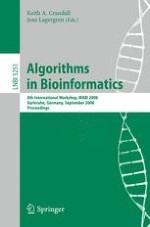This book constitutes the refereed proceedings of the 8th International Workshop on Algorithms in Bioinformatics, WABI 2008, held in Karlsruhe, Germany, in September 2008 as part of the ALGO 2008 meeting. The 32 revised full papers presented together with the abstract of a keynote talk were carefully reviewed and selected from 81 submissions. All current issues of algorithms in bioinformatics are addressed, reaching from mathematical tools to experimental studies of approximation algorithms and reports on significant computational analyses. The topics range in biological applicability from genome mapping, to sequence assembly, to microarray quality, to phylogenetic inference, to molecular modeling.
